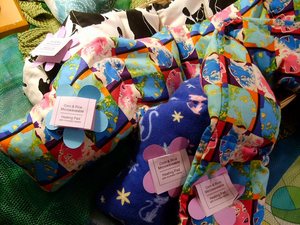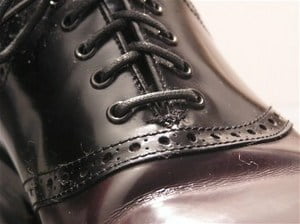When you feel achy and sore, there are few comforts more blissful than a steamy-hot, aromatic, herbal rice bag wrapped around your ouch-y places. When you have a migraine, there are few remedies as quick and effective as a cold rice bag wrapped around the back of your neck.
It is easy to make your own bag at home. Make two, and keep one in the freezer for when you need a cold one. Below I will cover the major considerations and options for quickly crafting your own bags for yourself or for a gift.
1. Choose Your Grain
Rice bags seem to be the most common, but other grains can be used. Some use dried peas or beans, buckwheat kernels or flax seed. All of these will work, but there are pros and cons to each.
Flax is a very lightweight seed. The seeds are small, so heat or cold will not be retained very long. This can be good for children or those who are very sensitive. Because of the light weight, this can be a good option for some injuries where pressure causes pain. However, because of the light weight it may not be as good for perfectly molding around the body part being treated.
Buckwheat kernels are slightly larger than rice grains, so they hold heat slightly longer. They have a good weight to them so they mold well to the treatment area.
Dried peas and beans can break down over time and should not be heated as much as tougher grains. They have a nice weight to them and are very inexpensive.
Rice grains hold heat and cold very well and they have a good weight. The small kernels do a good job of molding around body parts to treat effectively.
Corn kernels (whole feed corn, not popcorn or cracked corn) are the largest grains, and therefore they retain their temperature the longest. This is great for prolonged treatment needs, and those with chronic pain issues find this useful for regular use. However, the large kernel size means that it will not fit tiny nooks and crannies as effectively as smaller grains.
My personal recommendation is to use a combination of corn and rice. Both of these grains are inexpensive and hold temperature well for a prolonged treatment, so you have the option to keep it on a long time or simply take it off sooner if you are done. The larger corn kernels hold temperature a long time and the smaller rice grains allow the bag to mold to every curve quite effectively. Plus, the corn has a very nice aroma when heated.
2. Choose Your Fabric
It is important to use a 100% natural fiber material for your bag. Many synthetic fibers use petroleum by-products in their production, and heating these petroleum products in the microwave could cause a fire. Your bag should be made of all cotton or linen material, both the exterior and the inner lining. And yes, I do recommend an inner lining. It makes the bag more durable, prevents any dust as the herbs break down a bit, and gives you added protection for your bag’s inner contents should the exterior become slightly wet. A great inner lining material for rice bags are old towels or cloth diapers. They are all cotton, thick and durable. If you do not have any, go to a thrift store and pick them up used for cheap.
The cover can be any snazzy calico print you like, or a lovely soft cotton flannel. You can also use linen which comes in various textures from nubby to silky. Just make sure it is a natural fiber, and make sure it does not have any sparkly or metallic threads woven in.
3. Choose Your Herbs
Lavender is the most popular, and it is wonderful for a relaxing scent. Lavender is also a vaso-dilator and as such, it is a good choice if you will be using your bag chilled for the treatment of headaches or migraines. The therapeutic properties of essential oils apply, as this is what is released when the herbs are heated. When you combine your grain with your herbs, the herbs should make up between 1/4 and 1/3 of the total volume of filler. You don’t want too much, or there won’t be enough grains to hold the temperature. You don’t want too little, or the scent will not last for long.
Other good choices for your bag are as follows:
Marjoram Leaves – Marjoram is a member of the same family as oregano. It has a sweet, herbal, floral aroma and is good for treating chronic pain, especially arthritis.
Mint – all of the mints are vaso-dilators and as such they are good for headaches and migraines when used in a chilled bag. The mints can also be stimulating, so take this into account when you choose your bag ingredients.
Chamomile Flowers – Chamomile has a wonderful apple-like fragrance and it very calming, but those who are allergic to ragweed can sometimes also be allergic to this herb.
Cardamom Pods – These have a beautiful spicy, exotic floral aroma.
Cloves – Also good for treating chronic pain.
Cinnamon bark – a few pieces in a bag can give a pleasing aroma, but use sparingly as the essential oils released from cinnamon can irritate skin and the pieces can also be sharp and poke-y.
Catnip – a soothing, relaxing aroma with hints of mint and apple, but it may become your cat’s favorite toy.
Hops – This flower has a slightly sour, wheat-like aroma and is calming.
Sweetgrass – Has a wonderful grass and honey aroma.
Sage – Use sparingly as part of a mixture, it has a bracing green, herbal aroma.
Rosemary – stimulating, increases alertness. It is also a vaso-dilator so it is good for chilled bags to treat headaches and migraines.
Mix your herbs in whatever combination appeals to you for both scent and effect. However, do not use essential oils. Most essential oils have a low flash point, so they will burn away rapidly when you microwave your bag. Not only does this mean that your bag becomes more flammable, it also means your scent will go away very quickly.
4. Make Your Bag
Once you have chosen your herbs and grains, it is time to make your bag. Get a friend to measure your spine from the base of your skull all the way to the sacrum, or tailbone. Add two inches (for seam allowance) to this number, that will be the long side of your rectangle. The width should be about 12 inches. This will give you a bag between 5 and 6 inches wide once you have sewn it shut. Cut out a rectangle of your cover fabric and your lining fabric. Now place your cover fabric on top of your lining fabric, with the print side up. Once you have lined up the pieces, press them flat with an iron to make them smooth. This creates a nicer end result when you are sewing. Once you have pressed the two pieces together, fold the rectangle in half width-wise, with the lining fabric on the outside and the cover fabric in the middle, to create a long tube the same length as your spinal column. Press this flat, then use straight pins to pin 2 sides of the tube together – one short side and one long side. Sew these two sides using a straight stitch, removing the pins as they go under the presser foot. You can also do this by hand – it does not take too long. Just make small, straight stitches and remember to use a 100% cotton thread.
Once you have sewn the first two sides together, you can turn your rice bag right side out. Now the cover fabric should be on the outside with the print facing out, while the inside contains the lining fabric.
Use a measuring cup to measure 1/2 cup of your grain/herb mixture and pour it into your bag. Shake it all down to the bottom and then straighten it out, using pins to seal off the section containing the herbs from the rest of the bag. Add another 1/2 cup of grains and repeat with the sealing. Continue until you come to the last section. Fill the last section, seal with pins, then fold the rough ends of the fabric under so that they are contained on the inside of the bag and stitch the bag closed. Now stitch each of the sections, removing pins as you go. This keeps the grain mixture from shifting around too much inside the bag, ensuring an even distribution of the heat/cold therapy wherever you apply it.
There you go! You are now the proud owner of a custom herbal therapy bag. Keep it or gift it, they are always greatly appreciated and with proper care (which basically means not getting them wet) they will last for many years.





